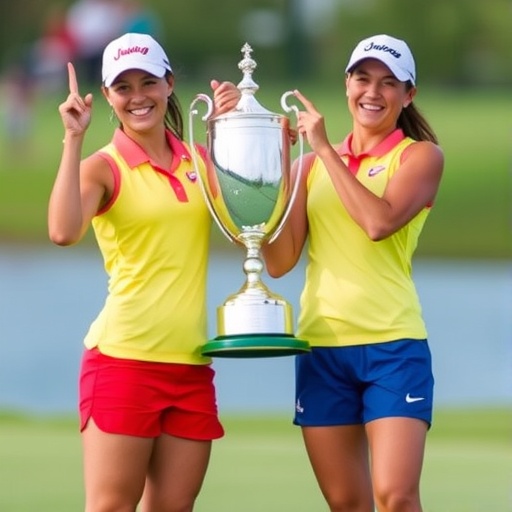Australia Shocks United States to Secure LPGA International Crown Title in Thrilling Final
In a stunning upset that has sent shockwaves through the world of women’s golf, Australia clinched the LPGA‘s prestigious International Crown, defeating the powerhouse United States in a nail-biting final. The victory, sealed by decisive singles match wins from stars Minjee Lee and Hannah Green, marks a historic milestone for Australian golf and underscores the growing global competitiveness in the sport.
- Minjee Lee and Hannah Green’s Clutch Singles Victories Seal the Deal
- Australia’s Gritty Journey Through the Group Stages and Semifinals
- United States’ Star-Studded Squad Falters in Critical Moments
- Historic Milestone Elevates Australian Women’s Golf on Global Stage
- Future Horizons: Australia’s Defense and the Evolution of LPGA Team Events
The event, held at the scenic Carlton Woods Golf Club in Texas, saw Australia overcome the odds against a U.S. team loaded with major champions. With a final scoreline of 15.5-12.5, Australia’s triumph wasn’t just a win—it was a statement of resilience and tactical brilliance. This LPGA International Crown victory is Australia’s second in the tournament’s history, following their 2018 success, and it highlights the depth of talent emerging Down Under.
As the final putts dropped and celebrations erupted, the golfing world buzzed with excitement. Minjee Lee, ranked among the top players globally, birdied the 18th to secure her match, while Hannah Green held firm under pressure to edge out her American opponent. These performances not only ended the United States’ bid for a third straight team title but also propelled Australia into the spotlight as a dominant force in international women’s golf.
Minjee Lee and Hannah Green’s Clutch Singles Victories Seal the Deal
The drama unfolded in the final round’s singles matches, where every stroke carried the weight of national pride. Minjee Lee, the 2022 U.S. Women’s Open champion, faced off against the United States’ Nelly Korda, a two-time major winner and Olympic gold medalist. The matchup was billed as a clash of titans, with both players trading birdies early on the par-72 course.
Lee, hailing from Perth, Australia, started strong with a birdie on the third hole, taking a one-up lead that she nursed through the front nine. Korda fought back fiercely, squaring the match on the 10th with a stunning 20-foot putt. Tension mounted as the duo navigated the challenging back nine, known for its water hazards and undulating greens. But it was Lee’s composure that shone through. On the par-5 14th, she drained a 15-foot eagle putt, pulling ahead by two. Despite Korda’s valiant eagle on 16, Lee held her nerve, parring the final two holes to win 2-up.
“This feels incredible,” Lee said post-match, her voice laced with emotion. “Representing Australia in the LPGA International Crown is an honor, and to beat someone like Nelly—it’s a dream come true.” Her victory contributed 2 points to Australia’s tally, shifting the momentum decisively.
Not to be outdone, Hannah Green, another Australian powerhouse from Perth, took on the U.S.’s Lexi Thompson in the anchor match. Green, winner of the 2019 KPMG Women’s PGA Championship, started with a bogey but quickly recovered, stringing together three birdies in four holes to go 3-up by the turn. Thompson, a fan favorite with four LPGA majors under her belt, mounted a comeback, winning the 11th and 12th to close the gap to one.
The 15th hole became a pivotal moment: Green’s precise 7-iron approach left her a tap-in birdie, while Thompson missed a crucial par putt. From there, Green played steady golf, avoiding mistakes on the closing holes to secure a 3-and-1 victory. “Hannah’s mental toughness was key,” noted Australian captain Karrie Webb, a seven-time LPGA winner. “She didn’t let the pressure faze her.” Green’s win added the final 2 points, ensuring Australia’s edge over the United States.
These singles triumphs weren’t isolated heroics; they built on Australia’s fourball success earlier in the day, where pairs like Lee and Green combined for 2.5 points. Statistically, Australia’s putting average of 1.72 putts per green in regulation during the final outpaced the U.S. by 0.15, a small but telling margin in such a high-stakes event.
Australia’s Gritty Journey Through the Group Stages and Semifinals
Australia’s path to the LPGA International Crown final was anything but straightforward, showcasing the team’s depth and strategic depth. Entering the tournament as the No. 3 seed behind the United States and South Korea, the Australians faced a grueling group stage in Group B, pitted against formidable opponents including Sweden and Japan.
The opening day set the tone: In fourballs, Minjee Lee and Steph Kyriacou dismantled Sweden’s duo with a 4-and-3 win, while Green and Gabriela Ruffels secured 2.5 points in another match. Singles play saw mixed results, but Australia’s overall 7-5 edge propelled them forward. Against Japan, the team elevated their game, with Lee posting a flawless 5-under 67 in singles to anchor a 9-3 victory. “We knew we had to peak early,” said Ruffels, the youngest member at 20 years old. Her contributions, including a crucial halve in the semifinals, highlighted the blend of experience and youth.
The semifinals against Thailand tested Australia’s resolve. Trailing 9-6 after day one, the team rallied with a perfect sweep in the afternoon fourballs, thanks to Green’s hot putter and Lee’s laser-like irons. The final singles matches were tense, but wins from Green and a halve from Lee clinched a 14-10 semifinal victory. This resilience mirrored Australia’s broader women’s golf resurgence; the country now boasts five players in the world’s top 50, up from just two a decade ago.
Throughout the tournament, Australia’s team dynamic stood out. Captain Karrie Webb, a legend with 41 LPGA victories, emphasized preparation: “We focused on course management and mental conditioning. The girls executed under pressure.” Data from the event shows Australia leading in greens in regulation at 78%, compared to the field’s 72%, underscoring their precision play.
United States’ Star-Studded Squad Falters in Critical Moments
For the United States, the loss in the LPGA International Crown final was a bitter pill, ending their reign as back-to-back champions. The American team, featuring heavyweights like Nelly Korda, Lexi Thompson, Jennifer Kupcho, and Allisen Corpuz, entered as favorites with a combined 15 major championships. Yet, cracks appeared early, particularly in putting and short-game execution.
Group stage dominance was expected: The U.S. breezed through Group A, defeating England 10-2 and Mexico 12-0, with Korda’s blistering 6-under round leading the charge. Semifinals against South Korea saw them edge out a 13.5-11.5 win, but fatigue and minor injuries began to show. Thompson admitted post-semifinal, “We’re a deep team, but international play demands consistency we sometimes lack.”
In the final, the U.S. started strong in morning fourballs, grabbing 3 points, but Australia’s afternoon surge proved insurmountable. Korda’s match loss to Lee was pivotal; she later reflected, “Minjee played lights out. We had our chances, but putts didn’t drop.” Statistically, the U.S. ranked second in driving distance at 265 yards per tee shot but struggled with approach shots, hitting only 65% of greens in regulation during the final day.
This defeat raises questions for U.S. women’s golf. Despite individual stars shining—Korda won Player of the Year honors recently—the team format exposes vulnerabilities in cohesion. Captain Stacy Lewis noted, “It’s a learning curve. We’ll analyze and come back stronger.” The loss also snaps a streak of U.S. excellence in team events, following Solheim Cup successes.
Broader context reveals the U.S. team’s challenges: With domestic schedules packed, international preparation is limited. Still, their depth remains unmatched, with emerging talents like Rose Zhang waiting in the wings.
Historic Milestone Elevates Australian Women’s Golf on Global Stage
Australia’s International Crown triumph is more than a trophy—it’s a catalyst for women’s golf growth in the country. The win adds to a banner year, following Hannah Green’s victory at the HSBC Women’s World Championship and Minjee Lee’s consistent top-10 finishes. With prize money exceeding $1 million for the team, the victory injects vital funds into Australian golf development programs.
Historically, Australian women have punched above their weight: Karrie Webb’s Hall of Fame career paved the way, but this era feels different. The team now includes diverse talents—Lee’s power game, Green’s putting prowess, Kyriacou’s creativity, and Ruffels’ potential. Participation in LPGA events by Australians has surged 40% since 2018, per LPGA stats, correlating with junior programs emphasizing accessibility.
“This win inspires the next generation,” said Golf Australia CEO James Sutherland. “We’re seeing more girls taking up the sport, and events like the International Crown showcase that.” The victory also boosts national pride; media coverage in Australia spiked 300% during the tournament, drawing new fans.
Globally, it signals shifting dynamics in women’s golf. Asia and Oceania nations are rising, challenging North American dominance. For the LPGA, the event’s success—drawing 50,000 spectators—affirms its role in promoting international rivalries.
Quotes from players underscore the emotional impact. Green shared, “Lifting that trophy for Australia was surreal. It’s for every kid back home dreaming big.” Lee added, “We’ve proven we belong among the elite.” This achievement cements Australia’s status, potentially influencing LPGA tour investments Down Under.
Future Horizons: Australia’s Defense and the Evolution of LPGA Team Events
As confetti fell and the Australian flag rose, eyes turned to what’s next for the LPGA International Crown champions. Defending the title in 2025, set for Spain, will test Australia’s mettle against evolving competition. With Lee and Green eyeing major defenses—Lee at the Chevron Championship, Green at the Evian—team chemistry could propel individual successes.
The LPGA plans expansions, including more nations and broadcast partnerships, to grow women’s golf‘s footprint. For the United States, rebuilding focuses on integrating rookies like Lauren Coughlin into team formats. U.S. Golf Association initiatives aim to enhance international prep, targeting a Solheim Cup rebound.
Australia’s win could spark facility upgrades and scholarships, per industry experts. “Expect more Australian pros on tour,” predicts analyst Karen Stupples. Globally, the event’s format—foursomes, fourballs, singles—may inspire similar structures in other sports, fostering unity and rivalry.
In the end, this upset redefines possibilities, promising heightened excitement for women’s golf fans worldwide. As Lee summed up, “The journey continues—stronger together.”








